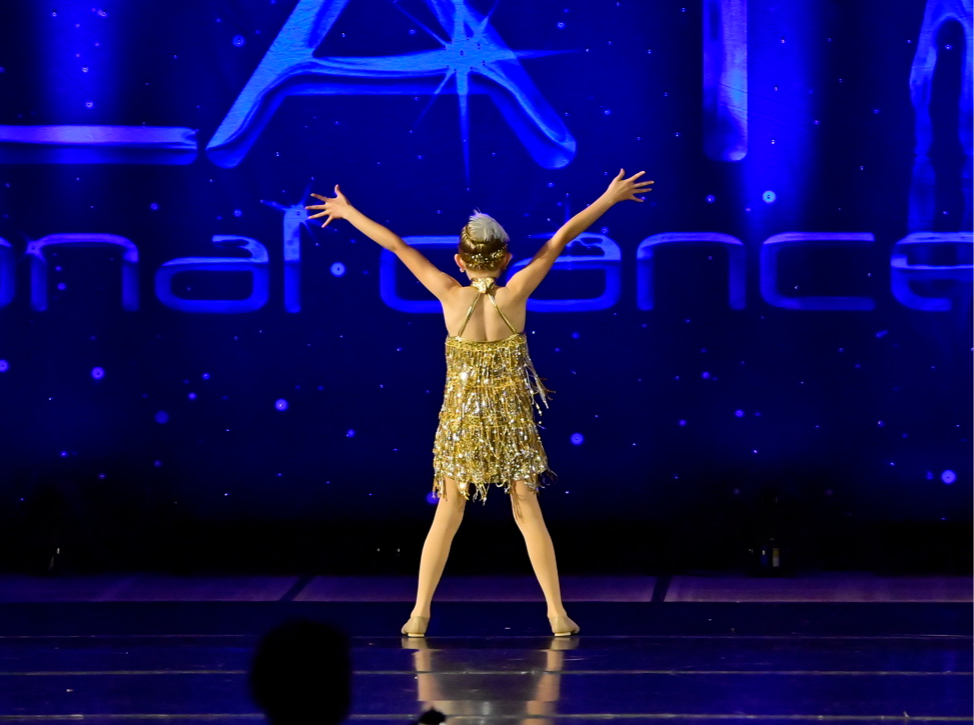Choreographers and Dance Moms, We Need to Talk
- Allison Harvey

- Jun 22, 2023
- 7 min read

And … that’s a wrap on the end of another dance season! Whew! We did it! Hopefully all of you got to see your dancers grow in artistry and technique, confidence and poise. Isn’t it great that our kids can express themselves (and your vision!) through this incredible art form?!
HOWEVER, after sitting through multiple dance competitions and performances, watching everything from the “minis” to the seniors from multiple dance studios (and seeing videos posted from fellow dance parents across the country), I am begging you: STOP PUTTING BABIES IN BIKINIS AND MAKING THEM TWERK ON STAGE. I can’t even with this anymore. Sweet Jesus, give me strength.
I am incredibly fortunate to have my kids at a dance studio where the leadership believes that little girls should look and act like little girls on stage. So, the choreography and costumes are age-appropriate. I had just assumed that all dance studios shared this mindset. (I mean, it was certainly that way when I was a kid!) Imagine my surprise when I started seeing pieces from other studios that were … well … otherwise. The first time I encountered this, I was sitting with my husband at a dance recital, and Gwen Stefani’s “If I Were a Rich Girl” came on over the speakers. Out onto the stage strutted approximately ten fourth-grade girls (I know, because I knew some of them) wearing fur bikinis. They promptly bent over toward the back wall and shook their tiny derrières directly at us. My husband turned to me with panic in his eyes and said, “I don’t know where to look! I feel like I could get arrested for just being here!” And that, my friends, is how I have felt multiple times in the last few years.
It's perhaps never more acute than at dance competitions. If you’ve never had the pleasure of attending a dance competition, let me set the stage for you (pun absolutely intended). You arrive at a hotel/convention center, and find a room (sometimes two) where there is a large, temporary stage set up on one end. In front of the stage is a long judge’s table, where (usually) three judges sit and make notes about the dances. The music never stops in the room, going from dance number to dance number, with something loud and dance-party-techno-y in between, generally at a volume level of at least an eight out of ten where ten is the front row at a Metallica concert. The lights are off or significantly dimmed, with the stage lights as your main source of illumination in the room. Rows and rows and rows of chairs are set up where people come and go, cheering for their dancers and then hastily running out to help with costume changes. This goes on all day (7:00 a.m. to 11:00 p.m.) for roughly three days, with groupings of dancers together (so, all the six-to-eight-year-old jazz numbers are back-to-back-to-back, the nine-to-eleven-year-old lyricals are next, etc.). After an hour or two, the judges take a break and come back for awards where typically every dancer receives a rating (Gold/High Gold/Platinum/Special-Whatever-Name-of-the-Competition) and they get a medal. Dancers are then ranked as the best in category (sometimes a top five or a top ten) and special awards given out by the judges for things they want to highlight. These judges typically come in from all over the country and are almost always high-energy, kind, and funny, as well as accomplished and well-pedigreed. By the way, I tip my cap to those judges! I’m exhausted by the end of Day One and can only imagine what they feel like! (I also hope they wear earplugs to avoid hearing loss!) I’ve gotten to see some beautiful ballet, thought-provoking contemporary, and explosive tap numbers, among others. A lot of that really is a joy.
But the parade of the mini and petite dancers in the jazz divisions at these competitions is really what’s driven me to near insanity. Most recently, I have seen elementary schoolgirls (we’re talking about eight- or nine-year-olds) prancing onto a stage in sparkly, sequined two-pieces, licking their lips, and thrusting their hips to a twenty-first-century version of “Let’s Misbehave.” I also can’t unsee the tiny child brides (literally, five- or six-year-olds) that looked like they’d be perfectly at home wiggling in the clubs in Nashville on a bachelorette weekend to “Going to the Chapel,” complete with facial expressions that evoke images of backup dancers in "Baby Got Back." I wish I could tell you that this was an exaggeration. It is not. The most popular move I saw this year is one that I’m (un)affectionately calling “The Aggressive Crotch.” This is where a dancer holds their leg up near their forehead with both hands and then leans forward into the audience, as if to say, “Hey! Check out my labial folds!” Dear Lord. Please. Make it stop. We get that you’re flexible. There are other (appropriate) ways to show that. Point it at the wings, please.
So, choreographers, this is on you. Stop it. You’re better than this. These are CHILDREN. And they’re learning from you. If you’re setting this kind of choreography on a child, they’re going to do it. Because they love and respect you. And because you’re the boss. I know that you love them too, but there is a cost here. I don’t know if you think you have to do this to win, but I’ve seen with my own eyes that you do not. I’ve seen powerful, energetic, gorgeous dancers win with choreography that showcased their gifts without resorting to exploiting their bodies. My own daughters have received top awards with classical ballet and flapper-inspired choreography (see photo above). If the dancer can execute the moves well, that’s all they need to do. A seven-year-old doesn’t need to act like they’re twenty-two. In short, STOP SEXUALIZING OUR CHILDREN. And to be clear, I have nothing against using hips. I’ve seen some fantastic Latin dance numbers this year where the hips were clearly and intentionally part of the culture of the dance. That’s not what I’m talking about. I’m talking about the combination of 1) choosing music that implies sex, 2) encouraging sultry facial expressions, and 3) setting choreography that mimics intercourse. There is zero need for this.
And parents, this is on us too. I know I said “Dance Moms” in my title, but you know I really mean “Dance Parents.” I love a totally invested Dance Dad! But if you’re cheering and screaming “Get it!” as your little one is looking like they’re moments away from joining the cast of “Baby Girls Gone Wild: Dance Edition,” maybe think about what it is you’re encouraging them to get. Because if they got what it looks like they’re trying to get, you’d have people (rightfully) arrested. And that’s the biggest issue I have here.
We’re living in an age when predators have more access than ever to our children. Every single day, I see posts on social media about new and horrifying ways these monsters are getting to them: posing as other kids, grooming through messenger features in otherwise “safe” apps that might be on their devices, etc. And if we’re encouraging our kids to shake what [you] gave them in a judge’s face while wearing essentially little more than panties, what’s the message when a non-dance person asks them to do the same for a camera? If we’ve endorsed it with our praise and applause, wouldn’t it be okay? “Gosh Mom, you said I did so well in my dance today in front of a whole room full of strangers, but I can’t do this same move in my own room on my iPad for this really nice, funny guy who says he thinks I’m pretty?” This. Is. A. Problem.
And I get it. Parents and teachers, you want to see your kids succeed. So do I. I want to see that beaming smile when they feel great about themselves or when they get the score they were hoping for. I want my kids to win those judges’ awards too. But not like this.
I also get that it’s funny to see a little human looking and moving like an adult. I’m just as guilty of giggling when I got the viral video of the South American toddler in a diaper wiggling on a table. I know this is why the crowd goes wild when we see a kid one-hundred-percent committed to a move that’s too mature for them. It’s unexpected and the shock value lands. It does. BUT it doesn’t make it right.
I was recently reminded of an old adage that applies to this situation: Right is right, even when no one is right. And wrong is wrong, even when everyone is wrong.
I have this conversation with my kids a lot. And my own little dancers have a hard time understanding why they see these pieces get rewarded with special judges’ awards or win their divisions. It is so frustrating when we have conversations about what is appropriate and inappropriate behavior, and then see the opposite playing out in front of us. Judges, you’re complicit here. You can choose to highlight the dancers who are excelling in an age-appropriate way, and, likewise, you can send a message to studios about what is and isn’t acceptable.
A quick Google search (I know, probably not the most reliable data, but it’s the best I’ve got) estimated that there are nearly 25 million dancers aged six and up in the U.S. That's a LOT of dancers to mold, which is wonderful news as far as keeping this art form alive goes, but we MUST change the way we are approaching this. As we mature, so do our views and experiences. Choreographers, I can only imagine how rewarding it must be to see your vision — how you interpret the emotion in music through physical movement, a moment in time, never exactly the same way twice — come to life. Please remember that your 20+ years of life experience are vastly different from the little humans you might be working with. Please try to crawl into that memory of when you were that age and then feel all of those feelings from that perspective.
To be clear, I'm talking about our smallest dancers, however, this applies to children of all ages. It makes sense that our teenaged dancers would be wrestling with how to settle into their changing bodies (not to mention the complicated emotions that come with adolescence) and I hope that you, choreographers, are having conversations about which feelings and emotions dance could help them process. (For example, I saw a fantastic contemporary solo this year that focused on "two-faced" behavior and the middle-school-aged girl who danced it clearly understood the intention behind it. How many of us also remember middle school that way?) For so many kids, the dance studio is their safe space, where they can express who they are, where they can take chances, where they can fall and get back up again. But I firmly believe that setting choreography that’s too sexual on our children negates all the good that comes from that nurturing environment. This is a major problem that we have to address.
Parents, choreographers, and judges, please demand that we do better. Our children’s safety is worth more than a shiny, plastic trophy.










































Comments